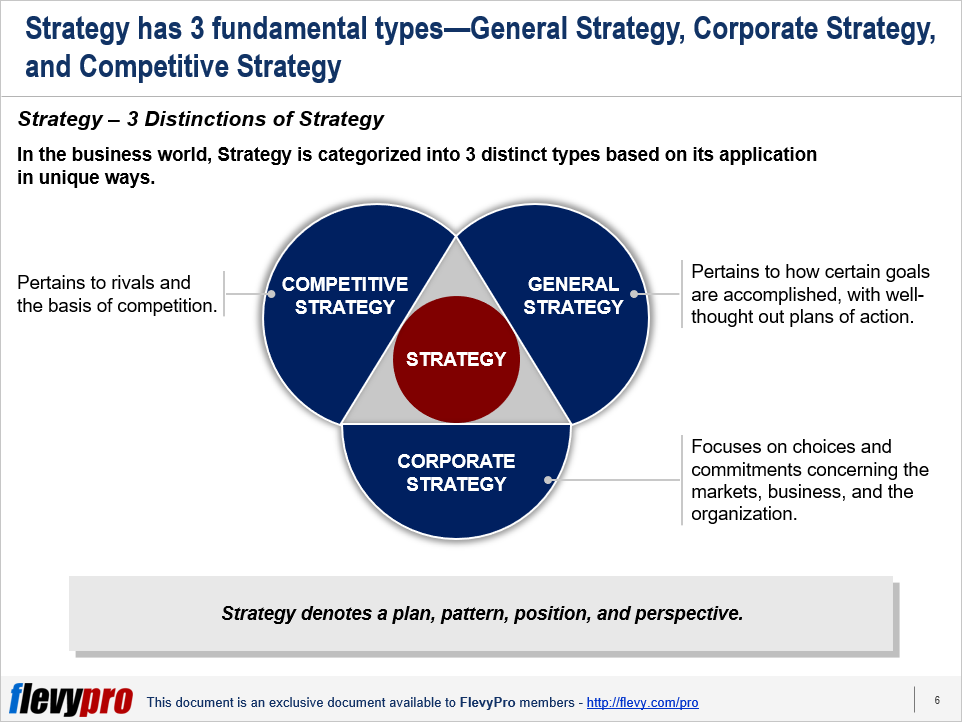Editor's Note: Take a look at our featured best practice, Growth Strategy (41-slide PowerPoint presentation). The reality is: all businesses face the challenge of achieving sustainable Growth. They need viable Growth Strategies. So, what is Growth Strategy? It is the organization's high-level Corporate Strategy Plan that outlines everything the organization needs to do to achieve its goals for [read more]
How to Differentiate Between General, Corporate, and Competitive Strategy?
Also, if you are interested in becoming an expert on Strategy Development, take a look at Flevy's Strategy Development Frameworks offering here. This is a curated collection of best practice frameworks based on the thought leadership of leading consulting firms, academics, and recognized subject matter experts. By learning and applying these concepts, you can you stay ahead of the curve. Full details here.
* * * *

Strategy is about making sound decisions about unforeseen problems. It’s about selecting the right options—about matters that are often quite ambiguous today but have great significance in the future—based on thorough contemplation, detailed analysis, and creative ideas. Broadly speaking, strategy encompasses these 3 main elements:
- A vision and direction
- A certain position or pattern
- A deliberated Strategic Plan to achieve strategic goals and vision
Great strategists execute their plans, analyze the results, evaluate their actions, and perform course correction based on the outcomes. They are not afraid of even revamping their approach entirely. Senior leaders should clarify their understanding of the concept of strategy and draw attention to the importance of differentiating between the 3 distinct types of strategies before formulating their own course of action:
- General Strategy
- Corporate Strategy
- Competitive Strategy
Let’s delve deeper into the 3 types of strategy.
General Strategy
General Strategy indicates how a specific objective will be achieved, with well-thought-out plans. The focus of this type of Strategy is on ends (objectives and results) and means (the resources we have to achieve the objectives). Strategy and tactics combined bridge the gap between ends and means; where Strategy deals with deploying the resources at our disposal while tactics govern their utilization. A pattern of decisions and actions marks progress from the starting point to achievement of objectives in General Strategy.
Senior executives need to deliberate on the following questions before devising their General Strategy:
- What do we do?
- Why are we here?
- What kind of business are we?
- What kind of business do we want to become?
- What is our purpose? What are the results we seek?
- What is our existing Strategy, is it explicit or tacit?
- What Strategy and plans may bring about the results we want?
- What resources we have at our disposal?
- Are there any constraints in terms of resources that limit our actions?
Corporate Strategy
Corporate Strategy describes what a company does, the purpose of its existence, and what it aims to become. Corporate Strategy focuses on choices and commitments concerning the markets, business, and the organization. Corporate Strategy classifies the markets and the businesses in which a company will operate. This type of strategy is typically decided in the context of defining the company’s mission and vision.
A detailed assessment of the existing strategy, market, competition and environment is critical for devising the Corporate Strategy. Strategists indicate that there are critical elements that should be factored in while formulating Corporate Strategy. These elements include product or service offerings, resources, marketing and sales approaches, manufacturing capabilities / capacity, customers, distribution channels, technology, type of market and its requirements, and revenue and profit goals.
While formulating Corporate Strategy, senior executives should consider and seek answers to the following questions:
- What is our existing Corporate Strategy?
- Is our Corporate Strategy explicit or tacit?
- What are the critical assumptions that make our existing strategy viable?
- What is going on in the market—in terms of social, political, technical and financial environment?
- What do we seek to accomplish in terms of our growth, size, and profitability targets?
- What markets we are eyeing to compete in?
- What businesses we intend to operate in?
- What locations and geographies will we compete in?
Competitive Strategy
Competitive or Business Strategy specifies for an enterprise the core reason on which it contests its rivals. It depends on an organization’s competences, advantages, and disadvantages compared to the market and the rivals.
Interested in learning more about the General, Corporate, and Competitive Strategies? You can download an editable PowerPoint on The 3 Distinctions of Strategy here on the Flevy documents marketplace.
Do You Find Value in This Framework?
You can download in-depth presentations on this and hundreds of similar business frameworks from the FlevyPro Library. FlevyPro is trusted and utilized by 1000s of management consultants and corporate executives. Here’s what some have to say:
“My FlevyPro subscription provides me with the most popular frameworks and decks in demand in today’s market. They not only augment my existing consulting and coaching offerings and delivery, but also keep me abreast of the latest trends, inspire new products and service offerings for my practice, and educate me in a fraction of the time and money of other solutions. I strongly recommend FlevyPro to any consultant serious about success.”
– Bill Branson, Founder at Strategic Business Architects
“As a niche strategic consulting firm, Flevy and FlevyPro frameworks and documents are an on-going reference to help us structure our findings and recommendations to our clients as well as improve their clarity, strength, and visual power. For us, it is an invaluable resource to increase our impact and value.”
– David Coloma, Consulting Area Manager at Cynertia Consulting
“As a small business owner, the resource material available from FlevyPro has proven to be invaluable. The ability to search for material on demand based our project events and client requirements was great for me and proved very beneficial to my clients. Importantly, being able to easily edit and tailor the material for specific purposes helped us to make presentations, knowledge sharing, and toolkit development, which formed part of the overall program collateral. While FlevyPro contains resource material that any consultancy, project or delivery firm must have, it is an essential part of a small firm or independent consultant’s toolbox.”
– Michael Duff, Managing Director at Change Strategy (UK)
“FlevyPro has been a brilliant resource for me, as an independent growth consultant, to access a vast knowledge bank of presentations to support my work with clients. In terms of RoI, the value I received from the very first presentation I downloaded paid for my subscription many times over! The quality of the decks available allows me to punch way above my weight – it’s like having the resources of a Big 4 consultancy at your fingertips at a microscopic fraction of the overhead.”
– Roderick Cameron, Founding Partner at SGFE Ltd
“Several times a month, I browse FlevyPro for presentations relevant to the job challenge I have (I am a consultant). When the subject requires it, I explore further and buy from the Flevy Marketplace. On all occasions, I read them, analyze them. I take the most relevant and applicable ideas for my work; and, of course, all this translates to my and my clients’ benefits.”
– Omar Hernán Montes Parra, CEO at Quantum SFE

Want to Achieve Excellence in Strategy Development?
Gain the knowledge and develop the expertise to become an expert in Strategy Development. Our frameworks are based on the thought leadership of leading consulting firms, academics, and recognized subject matter experts. Click here for full details.
"Strategy without Tactics is the slowest route to victory. Tactics without Strategy is the noise before defeat." - Sun Tzu
For effective Strategy Development and Strategic Planning, we must master both Strategy and Tactics. Our frameworks cover all phases of Strategy, from Strategy Design and Formulation to Strategy Deployment and Execution; as well as all levels of Strategy, from Corporate Strategy to Business Strategy to "Tactical" Strategy. Many of these methodologies are authored by global strategy consulting firms and have been successfully implemented at their Fortune 100 client organizations.
These frameworks include Porter's Five Forces, BCG Growth-Share Matrix, Greiner's Growth Model, Capabilities-driven Strategy (CDS), Business Model Innovation (BMI), Value Chain Analysis (VCA), Endgame Niche Strategies, Value Patterns, Integrated Strategy Model for Value Creation, Scenario Planning, to name a few.
Learn about our Strategy Development Best Practice Frameworks here.
Readers of This Article Are Interested in These Resources

|
|
104-slide PowerPoint presentation
|
|
98-slide PowerPoint presentation
| |||
About Mark Bridges
Mark Bridges is a Senior Director of Strategy at Flevy. Flevy is your go-to resource for best practices in business management, covering management topics from Strategic Planning to Operational Excellence to Digital Transformation (view full list here). Learn how the Fortune 100 and global consulting firms do it. Improve the growth and efficiency of your organization by leveraging Flevy's library of best practice methodologies and templates. Prior to Flevy, Mark worked as an Associate at McKinsey & Co. and holds an MBA from the Booth School of Business at the University of Chicago. You can connect with Mark on LinkedIn here.
Top 10 Recommended Documents on Growth Strategy
» View more resources Growth Strategy here.
» View the Top 100 Best Practices on Flevy.














